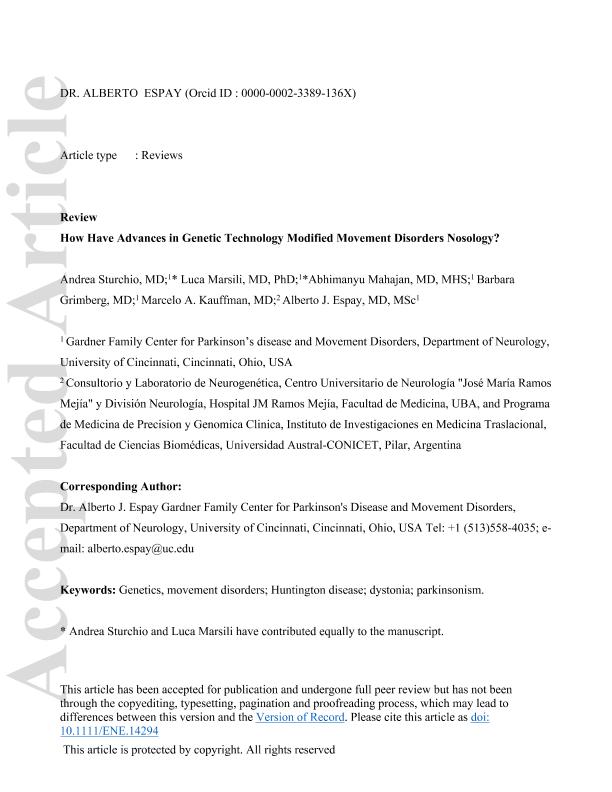Mostrar el registro sencillo del ítem
dc.contributor.author
Sturchio, A.
dc.contributor.author
Marsili, L.
dc.contributor.author
Mahajan, A.
dc.contributor.author
Grimberg, M.B.
dc.contributor.author
Kauffman, Marcelo Andres

dc.contributor.author
Espay, A.J.
dc.date.available
2022-02-16T12:53:48Z
dc.date.issued
2020-04
dc.identifier.citation
Sturchio, A.; Marsili, L.; Mahajan, A.; Grimberg, M.B.; Kauffman, Marcelo Andres; et al.; How have advances in genetic technology modified movement disorder nosology?; Wiley Blackwell Publishing, Inc; European Journal of Neurology; 27; 8; 4-2020; 1461-1470
dc.identifier.issn
1351-5101
dc.identifier.uri
http://hdl.handle.net/11336/152108
dc.description.abstract
The role of genetics and its technological development have been fundamental in advancing the field of movement disorders, opening the door to precision medicine. Starting from the revolutionary discovery of the locus of the Huntington’s disease gene, we review the milestones of genetic discoveries in movement disorders and their impact on clinical practice and research efforts. Before the 1980s, early techniques did not allow the identification of genetic alteration in complex diseases. Further advances increasingly defined a large number of pathogenic genetic alterations. Moreover, these techniques allowed epigenomic, transcriptomic and microbiome analyses. In the 2020s, these new technologies are poised to displace phenotype-based classifications towards a nosology based on genetic/biological data. Advances in genetic technologies are engineering a reversal of the phenotype-to-genotype order of nosology development, replacing convergent clinicopathological disease models with the genotypic divergence required for future precision medicine applications.
dc.format
application/pdf
dc.language.iso
eng
dc.publisher
Wiley Blackwell Publishing, Inc

dc.rights
info:eu-repo/semantics/openAccess
dc.rights.uri
https://creativecommons.org/licenses/by-nc-sa/2.5/ar/
dc.subject
DYSTONIA
dc.subject
GENETICS
dc.subject
HUNTINGTON’S DISEASE
dc.subject
MOVEMENT DISORDERS
dc.subject
PARKINSONISM
dc.subject.classification
Neurología Clínica

dc.subject.classification
Medicina Clínica

dc.subject.classification
CIENCIAS MÉDICAS Y DE LA SALUD

dc.title
How have advances in genetic technology modified movement disorder nosology?
dc.type
info:eu-repo/semantics/article
dc.type
info:ar-repo/semantics/artículo
dc.type
info:eu-repo/semantics/publishedVersion
dc.date.updated
2021-09-07T15:19:25Z
dc.journal.volume
27
dc.journal.number
8
dc.journal.pagination
1461-1470
dc.journal.pais
Reino Unido

dc.journal.ciudad
Londres
dc.description.fil
Fil: Sturchio, A.. University of Cincinnati; Estados Unidos
dc.description.fil
Fil: Marsili, L.. University of Cincinnati; Estados Unidos
dc.description.fil
Fil: Mahajan, A.. University of Cincinnati; Estados Unidos
dc.description.fil
Fil: Grimberg, M.B.. University of Cincinnati; Estados Unidos
dc.description.fil
Fil: Kauffman, Marcelo Andres. Universidad Austral. Facultad de Ciencias Biomédicas. Instituto de Investigaciones en Medicina Traslacional. Consejo Nacional de Investigaciones Científicas y Técnicas. Oficina de Coordinación Administrativa Parque Centenario. Instituto de Investigaciones en Medicina Traslacional; Argentina
dc.description.fil
Fil: Espay, A.J.. University of Cincinnati; Estados Unidos
dc.journal.title
European Journal of Neurology

dc.relation.alternativeid
info:eu-repo/semantics/altIdentifier/url/https://onlinelibrary.wiley.com/doi/abs/10.1111/ene.14294
dc.relation.alternativeid
info:eu-repo/semantics/altIdentifier/doi/http://dx.doi.org/10.1111/ene.14294
Archivos asociados
